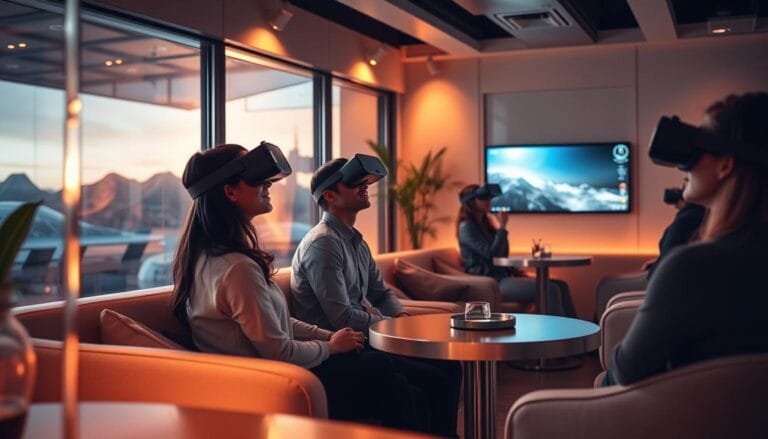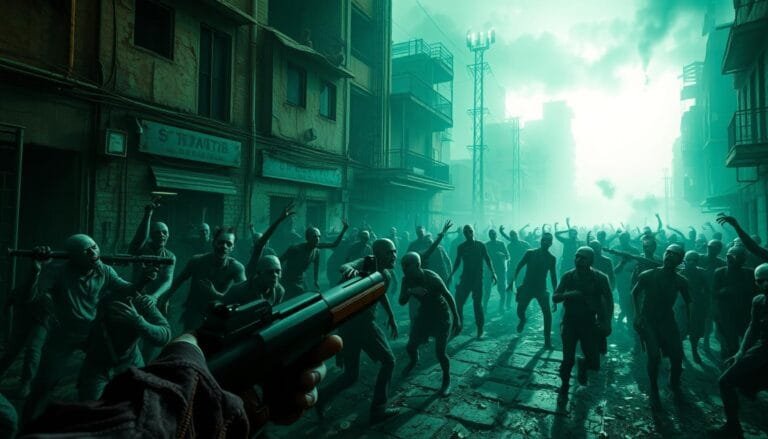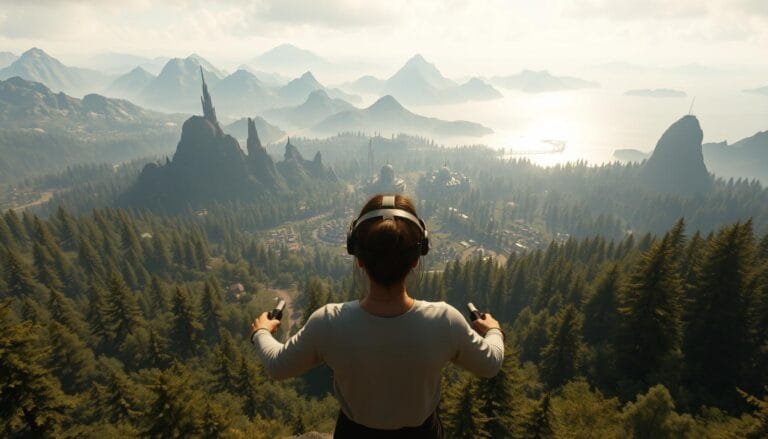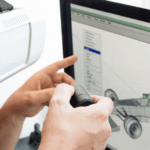From optical curiosities to working displays, a chain of inventions paved the way for modern mixed reality. In 1968, Ivan Sutherland and Bob Sproull built a ceiling‑mounted display that tied simple wireframe graphics to head tracking. That machine is often named the first vr headset, and it stitched earlier ideas into a new template.
The story reaches back to stereoscopes, early simulators, and remote camera rigs. Over time, breakthroughs in tracking, rendering, and optics fused into devices that deliver presence. Each step showed how human vision and engineering push the limits of perception.
This introduction frames the article’s goal: to trace the century‑long development that turned a lab curiosity into an influential medium. Expect a clear look at pivotal moments, the players, and how that progress shapes today’s choices in products and content.
Key Takeaways
- The 1968 Sutherland display synthesized prior inventions into a recognizably modern design.
- Depth cues, stereoscopy, and tracking unlocked real presence and lasting immersion.
- Early milestones set expectations for comfort, content, and scale in later devices.
- Understanding origins helps explain current market trends and product decisions.
- The path from lab rigs to consumer gear shows steady technical and cultural development.
Executive Overview: Why the “first vr headset” still shapes today’s immersive technology
A modest research rig established a practical blueprint for lifelike virtual environments. Sutherland’s 1965 Ultimate Display and the 1968 ceiling‑mounted device introduced core systems: stereoscopy, head tracking, real‑time computation, and wireframe rendering. Those elements remain central to modern reality experiences.
Blueprint to product: advances in optics and sensors moved lab prototypes into consumer gear. Arcade systems, Google Cardboard, Gear VR, and PlayStation’s offering showed how low‑cost distribution and content ecosystems drive market growth.
The ripple effect runs from military simulators to everyday applications in healthcare, education, and industry. Early research set expectations for presence, comfort, and content that still guide product development and strategy.
Users gain clearer displays, better ergonomics, and simpler setup each generation. Yet enduring constraints—price, content libraries, and fit—echo the original limits and shape where value is created today.
- Core systems: stereoscopy, tracking, rendering.
- Commercial milestones: arcade pods, Cardboard, PS systems.
- Applications: training, therapy, simulation.
As hardware and content mature, the path points to deeper market integration and broader, meaningful applications.
Defining “First”: From concept to device and the criteria that matter
When we ask which machine began immersive reality, we must separate idea from engineering. Stories and fiction planted the concept, but a working device requires clear technical thresholds.
Conceptual origins give us vision and goals. Works like Pygmalion’s Spectacles sketched what immersion could feel like. Those ideas inspired labs to build real systems.
What a true prototype must include
- HMD form factor and a stereoscopic display.
- A reliable tracking system for head position and rotation to update perspective.
- Responsive computer graphics that allow interactivity and real‑time feedback.
- Practical user concerns: comfort, weight balance, visual clarity for longer sessions.
Field of view, low latency, and stable imagery shape presence and comfort. A device might offer stereo images or simple tracking alone. But only the combination of these elements approaches modern immersive reality.
Early Visionaries: Stereoscopy to Sensorama and the idea of virtual reality
Early inventors and storytellers sketched sensory machines that taught engineers what immersion could feel like. These milestones married optical science with bold imagination, and they set high goals for later technical development.
1838 Wheatstone stereoscope: binocular vision, depth, and immersion
Charles Wheatstone demonstrated stereopsis by showing how two slightly offset images create convincing depth. His mirror stereoscope proved that the brain fuses binocular input into a three-dimensional sense of space.
1935 Pygmalion’s Spectacles: storytelling that predicted many senses
S.H. Weinbaum’s tale imagined goggles that added sight, sound, smell, taste, and touch. The story raised expectations that devices could deliver full sensory experiences well before engineers tried.
1962 Sensorama: multisensory arcade booth with video, audio, wind, and scent
Morton Heilig’s Sensorama combined stereoscopic video and stereo audio with wind, vibration, and scent. It was a public installation that hinted at what multisensory reality could offer.
- Impact: Stereoscopy proved depth cues; fiction set sensory goals.
- Sensorama: showed noninteractive multisensory experiences could delight audiences.
- Legacy: these milestones influenced later displays and the shift to real‑time rendering.
First HMDs: Telesphere Mask and Headsight as stepping stones
In the early 1960s, innovators split the challenge: one team refined wearable imagery while another tackled motion tracking for remote viewing.
1960 Telesphere Mask: stereo 3D images and sound without tracking
Morton Heilig’s Telesphere Mask proved that a compact display and stereo audio could be worn to deliver convincing depth and presence.
The Mask showed how cinematic three‑dimensional imagery could wrap the user’s senses, even though it lacked any motion input. Without head coupling, the wearer could not change viewpoint, so immersion stayed visually strong but interaction felt limited.
1961 Philco Headsight: military-grade head tracking with remote camera
Philco’s Headsight added a practical tracking system that steered a remote camera to mirror the user’s head movements.
It targeted hazardous environments and training. The setup offered situational awareness and proved that motion coupling could give operators better control at a distance.
- Complementary advances: one device emphasized visible realism; the other proved robust motion linkage.
- Practical roots: military and industrial needs drove early design choices for safety and utility.
- Legacy: ergonomics, head coupling, and calibration lessons from these prototypes informed later integrated systems.
Neither machine produced computer‑generated worlds, but together they revealed the essential parts that must merge. Their lessons guided engineers toward the integrated technology and systems that enabled full immersion.
The Sword of Damocles: The first true VR headset in 1968
In 1968 a bulky lab rig hung from the ceiling and reframed what immersion might mean for computing.
Sutherland and Sproull’s ceiling‑mounted device combined a head‑worn display with real‑time computer graphics and motion sensors. The rig rendered simple wireframe shapes and updated perspective as the wearer moved.
Sutherland’s Ultimate Display and interactive vision
The Sword of Damocles embodied the Ultimate Display idea: a system that links input, computation, and output to create interactive, reality‑like simulations. It proved a laboratory concept could deliver presence when tracking, rendering, and display worked together.
- Defining features: ceiling mount, head‑coupled perspective, wireframe graphics.
- Limitations: weight, comfort, and minimal visual detail kept it a prototype.
- Legacy: it codified priorities—tracking accuracy, low latency, display clarity—that guided research, military sims, and commercial R&D for decades.
Expanding the Field: Military simulators, art labs, and early interactive systems
Military labs, art studios, and campus projects pushed immersive work beyond single prototypes into practical systems.
Flight training and wide‑view systems
GE and others built multi‑screen simulators that gave pilots a 180‑degree view for situational awareness.
Wide field displays and sensor fusion improved tracking, realism, and training fidelity long before consumer gear arrived.
Integrated cockpits and hands‑free control
Thomas Furness’s VCASS and the Super Cockpit (1986–1989) combined eye tracking, speech, gesture, and multiple sensors into a single system.
These platforms showed how integrated controls let a user operate hands‑free and focus on tactical decision‑making.
Interactive art and shared virtual space
Myron Krueger’s VIDEOPLACE used cameras to capture silhouettes so people could interact without goggles or gloves.
It created social virtual worlds and proved that responsive spaces can feel communal and playful.
First‑person navigation and urban exploration
MIT’s Aspen Movie Map let users steer a camera view through streets, prefiguring modern Street View navigation.
This project linked camera capture, mapping, and view orchestration—an early template for exploration applications.
- Impact: military research matured tracking and sensor fusion.
- Art labs: expanded social and nonwearable interaction techniques.
- Research funding: helped these developments move into systems used for training and exploration.
Arcades and Consoles: Virtuality, SEGA VR, and Nintendo Virtual Boy
Arcades and consoles pushed immersive play into public spaces and living rooms, forcing hardware and content to compete for attention.
Virtuality brought real‑time stereoscopic 3D and networked multiplayer to arcades. These systems let players meet in shared 3D spaces and showed an appetite for social, coin‑operated entertainment.
Public play and networked systems
Virtuality’s machines were a breakthrough: head‑worn displays, synced positions, and multiplayer matches made arcades into testing grounds.
For many users, the arcade experience was their first taste of presence in games.
SEGA’s pivot and safety concerns
SEGA teased a consumer product but never shipped it, citing concerns about safety and practicality. Instead SEGA launched the VR‑1 motion simulator in arcades.
This move shows how manufacturers balanced promise with public comfort and regulatory worries.
Virtual Boy: bold idea, limited execution
Nintendo’s Virtual Boy aimed to bring stereoscopic 3D to a console audience. Its red‑black visuals, poor ergonomics, and thin software library cut sessions short.
The machine lasted under a year, but it taught makers hard lessons about display quality, comfort, and the need for strong content.
- Effect: arcades proved demand for immersive entertainment even when home systems lagged.
- Lesson: comfort, color, and software depth shape longevity.
- Legacy: 90s experiments trained a generation of users and informed later design choices.
From Research to Market: VPL Research, gloves, and the language of VR
A handful of startups bridged academic research and commercial practice, shaping how people imagined immersion. VPL Research, founded by Jaron Lanier and Thomas Zimmerman, turned prototypes into sellable systems and gave the field a common name in 1987.
DataGlove brought hand presence to applications beyond labs. It translated finger motion into real input and seeded gesture interaction ideas used in today’s controllers and haptics.
The EyePhone familiarized developers with a portable display and sped headset development for design previews and training tools. Meanwhile, Sayre gloves used light emitters and photocells to pioneer finger tracking.
Crystal River Engineering advanced real‑time binaural audio for NASA’s VIEW project. Their work on spatial sound proved that audio is as vital as visuals for presence.
Commercial impact and lasting legacy
By packaging gloves, displays, and audio, these companies showed practical applications outside pure research. They helped builders focus on usability, content, and cross‑disciplinary collaboration.
- Bridging research and market: commercial device development made demos repeatable and useful.
- Language matters: naming the field accelerated partnerships and product investment.
- Legacy: glove and audio advances feed today’s controllers, haptics, and spatial audio systems.
Resurgence and Reinvention: Oculus Rift and the modern VR reboot
A new wave in the 2010s turned decades of lab work into consumer momentum and creative possibility.
Street View’s later stereoscopic 3D mode helped millions accept stitched panoramic navigation as a familiar way to explore places. That mainstream exposure primed users for deeper immersion and for 360 video storytelling.
Street View 3D and the 2010s momentum
Google’s step toward stereoscopic panoramas made immersive scenes feel practical, not just experimental. People began to expect interactive viewpoints on maps and tours.
2012 Oculus prototype and Kickstarter: wide field, PC-powered
Palmer Luckey’s 2012 oculus rift prototype offered a roughly 90-degree field of view and used PC-class rendering for smooth, detailed scenes.
The Kickstarter campaign raised about $2.4M and signaled strong pent-up demand. Developers returned to the platform with fresh energy for games and tools.
Platform bets: acquisitions, Cardboard, Gear, and console validation
Facebook’s 2014 acquisition of Oculus for $2B scaled hardware and content investment across the industry. That move accelerated platform and ecosystem development.
At the same time, Google Cardboard and Samsung Gear VR acted as low-cost on-ramps, introducing roughly millions of people to entry-level immersion.
Sony’s PS solution later proved that a console approach could work: curated content and easier setup helped validate a mainstream route to adoption.
- Why it mattered: wide FOV, tracking, and PC power reignited developer interest.
- Market signal: crowdfunding and big acquisitions proved demand and investment appetite.
- Creator possibilities: 360 video, interactive storytelling, and games found clearer paths to users.
Tracking Breakthroughs: From external sensors to inside-out and room-scale
Tracking breakthroughs made the physical room a playable stage for digital content. Precise position sensing let users move naturally through real space and interact with virtual objects. That change shifted design from seated demos to full-room experiences.
SteamVR Lighthouse and room‑scale immersion
The 2016 system from HTC Vive used external base stations and a laser sweep to deliver very low latency, high‑precision tracking. This tracking system unlocked robust room‑scale play and natural movement.
Benefits: stable visuals, improved hand‑eye coordination, and fewer motion‑related issues thanks to synchronized graphics and motion.
Inside‑out tracking and passthrough evolution
Windows Mixed Reality (2017) and later the Quest line moved sensors onto the device. Inside‑out tracking reduced setup friction and made mobile use easier.
- Passthrough lets users see the real world for safety and mixed‑reality overlays.
- Trade‑offs include occlusion limits and slightly lower absolute accuracy versus external stations.
- Controller and hand tracking design changed to match each approach’s strengths.
Impact: these advances broadened applications from seated demos to full‑room training, collaborative spaces, and enterprise deployments. Better tracking lowered barriers for multi‑user setups and practical mixed‑reality work.
Standalone Shift and Mixed Reality: Quest era to Vision Pro
Wireless, self-contained systems made immersion portable and lowered the barrier for developers and users alike.
Oculus/Meta Quest sparked the standalone shift in 2019 by packing inside‑out tracking and mobile compute into a single unit. The Quest 2 sold in the millions and proved that a wireless approach reduces friction and boosts adoption.
Oculus/Meta Quest: wireless freedom, app ecosystems, and scale
By removing tethering, Quest devices let creators ship apps that run anywhere. That freedom built a vibrant content ecosystem and gave developers clear signals about what users wanted.
Apple Vision Pro: micro‑OLED, eye/hand tracking, spatial computing
Apple’s Vision Pro pushed optics and sensing with micro‑OLED panels and integrated eye and hand tracking. It reframed the product as a spatial computing tool for productivity, not just entertainment.
Recent competitors and market positioning
Meta’s Quest 3 and 3S, Pico 4 Ultra, and HTC VIVE Focus Vision trade clarity, comfort, and price in different ways.
- Quest 3/3S: mixed reality polish and broad app stores.
- Pico 4 Ultra: strong value with high resolution at a mid price.
- VIVE Focus Vision: premium comfort and fidelity for enterprise use.
As optics and sensors improve, expectations rise for productivity, collaboration, and education applications. The market now splits between premium vision‑heavy devices and more affordable, scalable offerings. Ecosystems and content libraries will steer purchasing decisions as the lines between virtual and augmented reality converge.
Adoption, Markets, and Use Cases: Where VR creates value today
Across homes, clinics, and training floors, immersive experiences have found practical uses.
Applications now split between entertainment and enterprise, each drawing clear returns.
Gaming and entertainment: content hits and arcade renaissances
Home games proved early momentum. Titles like Beat Saber passed one million copies in under a year, showing how simple, replayable design drives mass appeal.
Location‑based arcades renewed interest too, offering high‑end rigs and social play that complement at‑home systems.
Healthcare, education, and industry: simulation, therapy, and training
Clinics use immersive exposure therapy and pain distraction. Industry relies on simulation for safer, faster skills transfer.
Education and design benefit from interactive video tours and virtual labs that let learners practice without real‑world risk.
Sales signals and lessons: platform reach and product design
Mobile waves showed reach: Google Cardboard shipped 10M units and Samsung Gear VR 5M. Console and PC traction followed; PlayStation sold ~5M units by 2020. By contrast, Virtual Boy’s ~0.8M sales highlight risks of poor ergonomics and weak content on console attempts.
- Map: dominant applications include games, training, therapy, design, and education.
- Market signals: sales numbers reveal adoption waves across mobile and console.
- Users: early communities from the oculus rift era helped seed today’s mainstream base.
Risks, Constraints, and User Concerns: Comfort, content, and accessibility
Designers now wrestle with trade‑offs that decide whether an immersive system feels natural or fatiguing. Comfort and practical limits shape adoption as much as technical specs.
Ergonomics, motion sickness, and field of view trade‑offs
Weight, balance, heat, and facial fit block longer sessions. Early consoles exposed how poor ergonomics cut use short.
Good tracking and low‑latency rendering reduce the effect of motion sickness, but they do not eliminate it for everyone.
Optics set a trade‑off between field clarity and the perceived field of view. Wider fields boost presence but demand higher resolution and better lenses.
Content ecosystems, pricing, and privacy considerations
Must‑have titles and enterprise software drive whether users keep a device. Content gaps limit value even when hardware impresses.
Pricing tiers and total cost of ownership — hardware, accessories, and subscriptions — determine who can realistically adopt a device.
“Privacy matters as sensors capture eye and hand signals that reveal intent and behavior.”
Designers must address data governance and accessibility to widen reach. Iterative development and inclusive design will steadily lower friction and expand safe, joyful use.
Conclusion
Decades of invention have layered optics, tracking, and compute into a practical architecture for immersive reality. The 1968 Sutherland ceiling‑mounted rig set that architecture in motion, shaping how engineers combine sensors, displays, and graphics to make presence possible.
That cumulative development across lenses, motion systems, and processors is why modern devices work so well. Teams kept improving comfort, latency, and software so experiences could move from labs to living rooms and training floors.
Adoption follows better content, comfort, and cost. Today’s growing applications — entertainment, training, healthcare, and education — show how people actually use immersive tools.
Look ahead with the same optimistic vision that guided early builders: the near future holds more seamless, inclusive experiences and new creative possibilities as ecosystems mature.
















